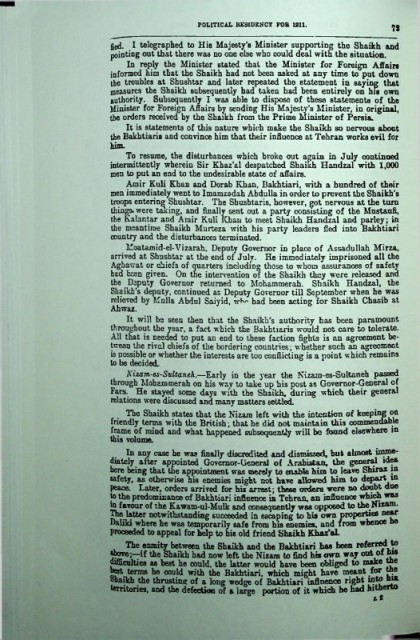Page 674 - PERSIAN 5 1905_1911
P. 674
POLITICAL RESIDENCY FOR 1911.
72
fied. I telegraphed to His Majesty’s Minister supporting the Shaikh and
pointing out that there was no one else who could deal with the situation.
In reply the Minister Btated that the Minister for Foreign Affairs
informed him that the Shaikh had not been asked at any time to put down
the troubles at Shushtar and later repeated the statement in saying that
measures the Shaikh subsequently had taken had been entirely on his own
authority. Subsequently I was able to dispose of these statements of the
Minister for Foreign Affairs by sending His Majesty’s Minister, in original,
the orders received by the Shaikh from the Prime Minister of Persia.
It is statements of this nature which make the Shaikh so nervous about
the Bakhtiaris and convince him that their influence at Tehran works evil for
him.
To resume, the disturbances which broke out again in July continued
intermittently wherein Sir Khaz’al despatched Shaikh Handzal with 1,000
men to put an end to the undesirable state of affairs.
Amir Kuli Khan and Dorab Khan, Bakhtiari, with a hundred of their
men immediately went to Imarazadah Abdulla in order to prevent the Shaikh’s
troops entering Shushtar. The Shushtaris, however, got nervous at the turn
things.were taking, and finally sent out a party consisting of the Mustaufi,
the Kalantar and Amir Kuli Jthau to meet Shaikh Handzal and parley ; in
the meantime Shaikh Murteza with his party leaders fled into Bakhtiari
country and the disturbances terminated.
Moatamid-el-Vizarah, Deputy Governor in place of Assadullah Mirza,
arrived at Shushtar at the end of July. He immediately imprisoned all the
Aghawat or chiefs of quarters including those to whom assurances of safety
had been given. On the intervention of the Shaikh they were released ana
the Deputy Governor returned to Mohammerah. Shaikh Handzal, the
Shaikh’s deputy, continued as Deputy Governor till September when he was
relieved by Mulla Abdul Saiyid, had been acting for Shaikh Chasib at
Ahwaz.
It will be seen then that the Shaikh’s authority has been paramount
throughout the year, a fact which the Bakhtiaris would not care to tolerate.
All that is needed to put an end to these faction fights is an agreement be
tween the rival chiefs of the bordering countries; whether such an agreement
is possible or whether the interests are too conflicting is a point which remains
to be decided.
Nizam-es-Sultanek.—Early in the year the Nizam-es-Suitaneh passed
through Mohammerah on his way to take up his post as Governor-General of
Fare. He stayed some days with the Shaikh, during which their general
relations were discussed and many matters settled
The Shaikh states that the Nizam left with the intention of keeping on
friendly terms with the British; that he did not maintain this commendable
frame of mind and what happened subsequently will be found elsewhere in
this volume.
In any case he was finally discredited and dismissed, but almost imme
diately after appointed Governor-General of Arabisfcan, the general idea
here being that the appointment was merely to enable him to leave Shiraz in
safety, as otherwise his enemies might not have allowed him to depart in
peace. Later, orders arrived for his arrest; these orders were no doubt due
to the predominance of Bakhtiari influence in Tehran, an influence which was
in favour of the Kawam-ul-Mulk and consequently was opposed to the Nizam.
The latter notwithstanding succeeded in escaping to his own properties near
Daliki where he was temporarily safe from his enemies, and from whence lie
proceeded to appeal for help to his old friend Shaikh Khaz’aL
The enmity between the Shaikh and the Bakhtiari has been referred to
the Shaikh had now left the Nizam to find his own way out of nis
difficulties as best he could, the latter would have been obliged to make tne
best terms he could with the Bakhtiari, which might have meant for tne
Shaikh the thrusting of a long wedge of Bakhtiari influence right into ma,
territories, and the defection of a large portion of it which he had hitne
L t

